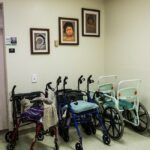Lower Manhattan may soon lose another hospital, as Mount Sinai Beth Israel is scheduled to close this summer in the face of financial losses.
And if past is prologue, Beth Israel’s campus — a tight pack of buildings by Stuyvesant Square park and between trendy enclaves like Gramercy and the East Village — could make developers giddy.
Indeed, the 2008 closure of the Cabrini Medical Center between East 19th and East 20th streets paved the way a decade later for Gramercy Square, a four-building high-end housing development from a team led by David Bistricer’s Clipper Equity.
Similarly, after shuttering in 2010, Saint Vincent’s Hospital on Seventh Avenue in Greenwich Village gave way to Greenwich Lane, a Rudin Management-developed multisite condo complex.
For its part, Beth Israel, which merged with Mount Sinai in 2013, says it does not attract enough patients to be a viable business and has lost $1 billion in a decade, despite investments worth hundreds of millions.
But turning out the lights hasn’t been so easy for Beth Israel, which was founded on the Lower East Side in 1889 and relocated to Stuyvesant Square in 1929. In April the state’s Department of Health, which needs to approve hospital closures, questioned why Beth Israel needed to close, possibly jeopardizing the site’s planned July 12 closing date, though hospital officials say a response is coming.
At the same time, local activists, public housing tenant groups and advocates for the disabled have jointly sued Mount Sinai over losing medical services, adding that Beth Israel’s 2023 losses of $172 million are not much worse than other Mount Sinai sites, such as the West Side’s Roosevelt Hospital, which lost $122 million last year.
“So why choose Beth Israel and blame the closure on losses?” the suit says. “Because the real estate on the south end of the Gramercy Park-Stuyvesant Park area is very, very valuable.”
Mount Sinai, which denies it has ulterior real estate motives, is seeking to dismiss the suit.
If Beth Israel does go dark, it would spell the end of another chapter in the long medical history of Stuyvesant Square, which for decades was the place to go to set broken bones, beat drug addiction, deliver babies, undergo brain surgery and train to be a nurse.
Some sites where that work was performed have already turned into luxury condos and college dorms, and the area’s reinvention may not be done yet.
281 First Ave.
Mount Sinai Beth Israel, which had 700 beds at the Stuyvesant Square campus at its peak, controls the entire block between East 16th and East 17th streets west of First Avenue, as well as other buildings nearby. But when it arrived in 1929 from the Lower East Side, the hospital, which catered to Russian Jewish immigrants, had a much smaller footprint, concentrated in an elegant tan-brick structure on the block’s westernmost side. At 13 stories, it was the tallest hospital in the world when it opened, according to its official history. The prewar structure, known as the Dazian Building, seems like the kind of medical facility developers love to convert. And a historic former Beth Israel site at 305 Second Ave. got similar treatment years ago. But most of the rest of the hospital’s current campus is awash in generally less-desirable Space Age-era architecture. Many of the half-dozen interconnected structures came about through a 10-year, $30 million expansion effort (the equivalent of $280 million today) in the 1950s and 1960s. They include Karpas Pavilion, an aqua-paneled building on East 16th Street completed in 1960 as housing for nursing students; Baird Hall, a 20-story beige offering from 1963 that also offered housing for the teaching hospital; and Linsky Pavilion, a circular 12-story site at No. 281 that is perhaps the most-recognizable structure. Opening a few years after the similarly rounded Guggenheim Museum in 1966, Linsky, named for the founder of Swingline Staples, was designed by Sid Schuman and Sam Lichtenstein, the S and L of the high-visibility firm known as SLCE Architects today.
318 E. 15th St.
The New York Infirmary, a hospital founded in 1853 by the country’s first licensed woman doctor, Elizabeth Blackwell, set up shop on the north side of East 15th Street in 1875. Brownstones once located across the street, including at No. 318, seem to have also had Infirmary functions. But in the mid-1960s, the institution razed a line of the buildings in order to construct the 12-story, white-brick apartment house standing at the address today. Offering housing to hospital workers, No. 318 was developed under the Mitchell-Lama program, through which developers could obtain low-interest loans and property tax breaks in exchange for keeping rents low. But landlords (which later included New York University through a merger) paid off the mortgage in 1997, allowing No. 318 to exit the program for good. In 2008, developer Arun Bhatia snapped up the 141-unit property for $56 million and borrowed $92 million in 2017 for redevelopment. He then sold No. 318 in 2022 to the New School for $14.5 million, according to the city register. Now called Stuyvesant Park, No. 318 houses about 640 mostly first-year students, who can enjoy amenities like music practice rooms, art studios and a TV lounge.
Stuyvesant Square
Peter Gerard Stuyvesant, a descendant of Peter Stuyvesant, the last Dutch director-general of New Netherland, owned an estate that covered most of what is now Gramercy and Stuyvesant Town/Peter Cooper Village today. In 1836, as part of an ongoing effort to slice up and sell off his holdings, Stuyvesant donated the land for Stuyvesant Square, a verdant nearly four-acre, iron-fence-ringed spread split into two sections, courtesy of Second Avenue. (The divided-in-half look suggests what Gramercy Park and Washington Square Park might look like if plans to cut roads through them had come to pass.) Originally the two-block stretch along the park’s easternmost flank was Livingston Place, named for Stuyvesant’s mother, Margaret Livingston. But in 1954 city officials renamed the short street for Nathan Perlman, a Polish immigrant, lawyer and Republican Congressman who represented the city on Capitol Hill from 1920 to 1927. Perlman, who was also a Beth Israel vice president, died in 1952 at his hospital.
305 Second Ave.
Beth Israel is no stranger to selling local holdings, like this nine-story, block-width Classical Revival-style site, which from the 1960s onward was the Morris J. Bernstein Institute, a drug-rehab facility. But in 1984, Beth Israel sold the limestone, brick and terracotta edifice for $8 million to developers Barnet Liberman and Winthrop Chamberlin. They received approval to convert the property into a 127-unit condo two years later. Its duplexes and triplexes appear to have struggled to find takers during the recession in the late 1980s, and the building, rechristened Rutherford Place, functioned mostly as a rental until a new push in the mid-2000s to unload its homes. The 1902 property, on the National Register, was constructed with a $1 million donation from financier J.P. Morgan, a parishioner of St. George’s church on nearby East 16th Street. In its first decades, the building, which has sculptural reliefs of babies on its facade between its fifth and sixth floors, was known as the Lying-in Hospital and was one of the main places in the city for women to give birth. A Rutherford Place two-bedroom rental in mid-May was asking $12,000 a month, according to StreetEasy; the priciest two-bedroom condo could be had for about $3 million.
327 E. 17th St.
Beth Israel’s presence is not always towering but sometimes modest, like with this six-story skinny brick site that played a role in a notable controversy. The four-story townhouse that previously stood there was home to Czech composer Antonin Dvorak and his family from 1892 to 1895; a plaque says Dvorak’s New York years left him “happily inspired by the freedom of American life.” In 1989, Beth Israel purchased the Dvorak property for about $1 million, according to the city register, and announced plans to open a center for AIDS hospice care in its place. In early 1991, the city conferred protective landmark status on No. 327, but in an extremely unusual move, the City Council voted to overturn the designation a few months later. Some council members who supported the reversal suggested saving lives was more important than buildings. For its part, Beth Israel said renovations would cost $6 million versus $5 million to build anew, according to news reports from the time. Today, the structure at No. 327 is home to the 28-bed Mapplethorpe House, named for photographer Robert Mapplethorpe, who died in 1987 of AIDS. But Dvorak lives on, courtesy of a green-granite statue in Stuyvesant Square that was relocated from Lincoln Center in 1997. And his old block has been renamed Dvorak Place
345 E. 15th St.
This striking five-story Beaux-Arts edifice, from architect C. B. J. Snyder, has been a place to learn since it was built in 1907 on a city-owned 21-lot site. It was most famously home to Stuyvesant High School, the selective secondary school considered among the city’s best. But Stuyvesant didn’t start requiring its well-known tough entrance exams until 1920, according to a Landmarks Preservation Commission report on the protected property. It also did not allow girls until 1969. The high school departed in 1992 for a newer and larger facility on Chambers Street in Battery Park City. But No. 345, a 171,000-square-foot through-block site, remains an educational hub. The High School for Health Professions, the Institute for Collaborative Education and a special-education facility are based there today, though “Stuyvesant High School” remains inscribed over the entrance on East 16th Street.
301 First Ave.
Constructed in 1969 for medical students so they could be an easy walk away from their training grounds, the 24-story tower here was vacated as part of an earlier effort at downsizing by Mount Sinai after its 2013 merger with Beth Israel; Mount Sinai offloaded No. 301 in 2017 for $46.5 million, records show. The buyer, California-based CIM Group, flipped it two years later for $81 million to GFP Real Estate and Meadow Partners, which carved the high-profile corner site into a pair of commercial condos, one containing a parking garage and the other the tower’s 185 apartments. The GFP team then sold the residences in 2020 to the New School for $65.4 million. The college, whose red banners flutter on the facade, opened up a 630-student dorm in the high-rise the following year. No. 301’s zoning wouldn’t allow a 24-story structure today, which likely prompted the owners to convert and not demolish. In its medical dorm days, No. 301 was called Sylvia and Charles Gilman Hall. Sylvia Gilman’s grandfather was Moses Phillips, a Polish immigrant and pushcart shirt vendor whose business grew into the apparel behemoth Phillips-Van Heusen. Moses Phillips was also one of 40 people in 1889 to found a medical clinic on the Lower East Side, on now-gone Birmingham Street, that eventually evolved into Beth Israel hospital.
C. J. Hughes , 2024-05-21 12:03:03
Source link


